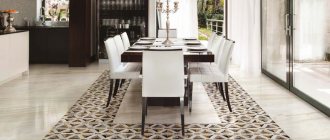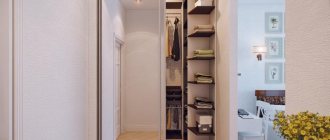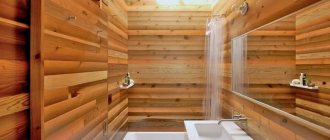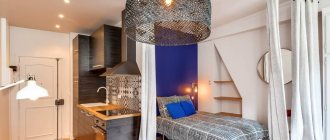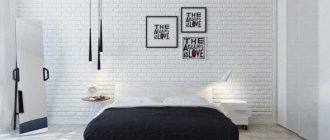11/23/2020 Read in 7 minutes.
In this article, you will learn what modern floor and wall tiles look like in interior design. We will show you completed renovations and design projects for bathrooms, kitchens, hallways and corridors, and also look at various ideas from different angles. Let's learn all about fashion design trends using examples from the portfolio of the Fundament Group of Companies!
Tiles in the kitchen interior: the best photos of the projects of the Fundament Group of Companies
view album in a new window
In the photo: Kitchen renovation in neoclassical style in white with an accent emerald apron
Below you will find out how you can use ceramic tiles in the design of a modern and trendy kitchen. We will show you ideas using real renovation projects and 3D renderings.
Modern kitchen-dining room with a U-shaped set in black and white tones
view album in new window
In the photo: Tiles in the interior of a kitchen in a modern style with a three-color set
On the floor of this kitchen we see tiles with square inserts, which enhance its decorative effect. This solution is popular in French and Mediterranean versions.
Luxurious open plan kitchen with built-in truffle units
view album in new window
In the photo: Beautiful dark brown kitchen with a dark apron in the Art Deco style
In this interior, unusually cut ceramic tiles are laid in a non-standard way, at an angle, and a material of a different color is placed around the perimeter to create contrast.
Exquisite kitchen set in Art Deco style with unusual facade decoration
view album in new window
In the photo: Kitchen interior in gray-stone colors
Here the design has a double effect. Its reflective surface lightens the look, while its geometric Art Deco pattern emphasizes the theme.
Modern kitchen with corner layout and accent backsplash
view album in new window
In the photo: Two-tone kitchen in white and walnut shades with a malachite apron
Ceramics can also act as the focal point of the interior, as in the example in the photo above with a bright accent apron.
Neoclassical kitchen with artistic finishes and trendy furniture
view album in new window
In the photo: Neoclassical style kitchen set in mouse gray color
First of all, marble tiles are very common in flooring. Usually the decoration has a solid format: the corridor, hall and loggia are decorated with the same material.
Stylish linear set of dusty color with stained glass cabinets
view album in new window
In the photo: Small kitchen in an ash color with parquet tiles on the floor
Another option for finishing tiles in the kitchen, this time with a wood effect, which creates the feeling of a European-style country house. The built-in heated floor will make such a room especially comfortable.
Application area
Due to its durability and variety of choices, beige porcelain tiles are used everywhere today. For example, it is used to create ventilated facades. Yes, you heard right, this material is used for exterior decoration of buildings. The material provides insulation and also completely protects the facade from moisture, since it does not allow water to pass through it.
Porcelain stoneware does not freeze, so it will retain its appearance for a long time. It is used inside permanent buildings and private buildings. Here it is a favorite among all customers due to its low surface abrasion rate.
Entrance hall and corridor in ceramic tiles
view album in new window
In the photo: Renovation of a pretty hall and hallway in a large apartment
In the portfolio of the Fundament Group of Companies you will find many examples of high-quality luxury renovations of apartments throughout Moscow. Among them, we have selected the most interesting options for halls and hallways. Watch below!
Luxurious furniture in the interior of a long and narrow corridor
view album in new window
In the photo: Elite renovation of the corridor in a luxury apartment
This stunning renovation in an apartment with an area of 133 square meters in the Setun Valley residential complex amazes with its splendor. A detailed selection of furniture, decorative items and lamps makes the overall image truly harmonious.
Beige tiles in the interior of the hallway with gold accents and mirror trim
view album in new window
In the photo: Turnkey renovation for a corridor in a luxury apartment
Another beautiful angle of this interior, full of incredibly aesthetic accessories. Pay attention to the mirrors with beveled finish in the wall decoration.
Renovation of an Art Deco style hallway in subdued colors
view album in new window
In the photo: Built-in storage systems in the hallway
Another hallway from our designers in the residential complex “Life on Plyushchikha”, in an apartment with an area of 276 square meters. The Art Deco style was ideal for this luxury and rich in exquisite details.
What to cut with?
You can cut it in different ways. Many people use a regular grinder with a circle. The cutting option is not aesthetically pleasing, but there is no need to buy any additional tools, which are expensive.
For a grinder, you buy a stone disc, which is quite durable and has a diamond coating, which makes the cutting process easier. The second option is to use a mechanical tile cutter. It is very difficult to process porcelain stoneware using such a tool. This is mainly possible when the thickness is up to 6 mm.
An electric tile cutter is often used to replace this option. Here the processing method is carried out by a motor whose speed is sufficient to perform a reliable and correct cut. The hand, unlike the grinder, will not tremble here, so it will turn out smoothly. Special wheels allow processing without chipping.
Design of floor and walls with tiles in the living room. Beautiful images
view album in new window
In the photo: Renovation of a three-room apartment in the Setun Valley residential complex
Below we present to you projects of living rooms with fashionable finishes and spectacular interior design. In each of them you will find exclusive and original ideas and techniques, implemented by our employees to order.
Modern living room with beige kitchen
view album in new window
In the photo: Kitchen-living room and hall in one room
In some rooms with open areas, ceramic flooring is used only in the hallway (hall, corridor) and kitchen (dining room). In the living room, you can lay parquet, laminate or engineered wood on the floor.
Exquisite living room interior with fashionable finishes
view album in new window
In the photo: Turnkey apartment renovation from the Fundament Group of Companies
If the living room has heated floors, you can choose tiles for the floor design throughout its entire area. For example, wood, ceramic parquet or with an unusual pattern.
Trendy image of a living room with a dining area
view album in new window
In the photo: Elite designer renovation of large apartments in the center of Moscow
In rooms with heated floors, marble-effect porcelain tiles have proven themselves to be excellent, as they look very aristocratic and fashionable.
Finishing work
You must wait a day before starting these steps. The day has passed. Now all you have to do is pull out the crosses from the grooves of the seams. It is necessary to seal the joints between the tiles with something. It’s good that their size is very large - there are fewer seams and they themselves are wider and longer. Standard caulk will always work for this, but silicone or resin caulk can also be used.
Wait another 2-3 hours, after which you can wipe the coating with a rag or sponge - just clean it from dirt that inevitably appears after repair work. That's all. Easy work for you and high-quality results!
Multi-colored ceramic tiles in the interior in the photo: white, gray, beige, light, black
view album in new window
In the photo: Tiles in the interior in the style of modern Art Deco
Below you will see various options for interior decoration in tiles in the photo. The most popular and trendy options remain white and black, gray and beige or any other light tile. The most fashionable prints are geometric patterns, imitation stone and mosaics.
Designer white ceramic tiles in the bathroom interior
view album in new window
In the photo: Tiles in the interior of a bathroom with a magnificent renovation
This luxury finishing option with different types of geometric patterns on tiles and furniture looks simply magical!
White and gray room decoration with shower and cream furniture
view album in new window
In the photo: Tiles in the bathroom interior and a magnificent room renovation in light colors
The neoclassical style in the decoration of this room allows you to create a sophisticated French atmosphere.
Black tiles and mosaics in the design of shower walls
view album in new window
In the photo: Small bathroom with a shower niche in black tiles
A great example of a simple but very stylish combination of different finishing materials. Please note that the shower pan threshold is designed like the walls and not like the shower floor.
Decorating an elegant bathroom with white and black and gold marble
view album in new window
In the photo: Renovation of a wonderful room in the Art Deco style
Art Deco is one of the most striking styles in interior design around the world. In the bathroom interior, tiles with a pattern (as in the photo) are most often used.
Dark chocolate glass mosaic in the shower area
view album in new window
In the photo: Renovation of a wonderful combined bathroom with an accent wall
Subtle accents on the shower area and the wall behind the bidet can be done using mosaic decoration. This makes the image more rich.
Stone gray accent wall trim in a combined bathroom
view album in new window
In the photo: White and gray bathroom in a modern style
An interesting option for finishing a wall with a stone look in a gray color scheme. For an aesthetic effect, floor tiles of a slightly lighter shade were chosen.
Bright shower interior with white floor and sanitaryware
view album in new window
In the photo: Wall decoration with 3D relief
Some materials have a 3D relief (waves, geometric patterns), which allows you to make the tile interior truly extraordinary. Here the white tiles in the bathroom interior in the photo look just great!
Black bathroom with combined porcelain stoneware and glass mosaic panels
view album in new window
In the photo: Design project of a room in black and white marble
Luxurious interior with glass mosaic panel in dark shades. Looks glamorous and elegant!
Marble bathroom with black and white stone, mosaic and wood paneling
view album in new window
In the photo: Luxurious renovation with shower and bowl
A wonderful example of the elegant combination of several materials in a small space. Our designers have created a project that successfully combines brevity and beauty!
Modern small bathroom with trendy finishes
view album in new window
In the photo: Tiles in the interior of a small bathroom
Modern style and laconic lines in the decoration of a small bathroom with a levitating bedside table. A fashionable solution for combining finishing materials and an integrated mirror.
Romantic room with pink accent wall
view album in new window
In the photo: White and pink bathroom with silver and blue accents
Attractive interior with pink accent wall and white marble porcelain tiles. The bedside table is made to order and, like the mirror, has lighting.
Advantages
Large tiles have many advantages:
- Maximum environmental friendliness: the tiles are completely safe for human health and do not harm the environment. It does not emit harmful substances and does not cause allergies.
- Long service life: if all the rules were taken into account when selecting a special glue and the correct conditions of use, the tiles can last a very long time, which can last for decades.
- High decorative qualities: porcelain stoneware facing material can embody any design ideas. The tile always looks very expensive and does not lose its appearance throughout its entire service life.
- Fire resistance: Ceramic tiles are those materials that do not burn, do not melt, and cannot be a source or material that supports combustion. In this regard, it can be used in fireplace and boiler rooms.
- Resistance to chemicals: tiled floors and walls can easily withstand the aggressive effects of various chemicals, which include detergents. True, it is worth considering the degree of class when choosing: D – does not have strong stability, AA – is the most stable.
- Good electrical insulation qualities: tile material is not a conductor of electricity.
- It perfectly resists the effects of many contaminants: the tile does not absorb any kind of dyes, does not accumulate dust, and is easy to care for and simply wash.
In connection with all of the above, we can conclude that ceramic tiles have many positive qualities. All remaining questions can be answered in the video below.
Finishing: brick, marble, stone, wood, hog, mosaic and concrete
view album in new window
In the photo: Wood-look floor tiles in the kitchen interior
Thanks to the printed top layer, ceramics can imitate various materials. For example, it can be made to look like stone, marble, wood or mosaic. The texture can imitate brick, wood or parquet! Let's learn more about the different tile variations below.
Scandinavian interior in white hog tiles
view album in new window
In the photo: Trendy hog in a small shower
Patchwork finishes are very popular in Scandinavian style, as is the case on the floor in this bathroom. A brick shaped hog is used here for a shower niche.
Trendy design of a combined bathroom in black and white
view album in new window
In the photo: Venetian terrazzo tiled floors
Venetian terrazzo is a self-leveling concrete floor containing pieces of stone, lime and marble. Depending on the specific brand, the tiles may have a terrazzo-type print or even be real piece terrazzo.
Blue tiles in the bathroom interior with an exclusive look
view album in new window
In the photo: Tiles on the walls in the interior. "Boar" blue
Hog is one of the most fashionable tile design options. In fact, it imitates brick, but in the version with a herringbone pattern it is more of an imitation of parquet.
Custom mosaic panel for niche design
view album in new window
In the photo: Stunning multi-colored mosaic decoration in the colors of beach sand and sea
This unique finishing option for the bowl and the accent wall behind it was invented by the designers of the Fundament Group of Companies!
Fashionable furniture in the interior with tiles for a combined bathroom
view album in new window
In the photo: Tiled floors in the interior of a room in a modern style
In this room, concrete-look ceramics look amazing in contrast to the plain version.
Renovation with original design and shower niche
view album in new window
In the photo: Examples of floor and wall tiles in different designs
This Art Deco style bathroom boasts a very nice and extremely neat combination of different areas in the wall decoration.
Bright room with gold accents and marble tiles
view album in new window
In the photo: A bright image of a room decorated with porcelain stoneware
A stylish solution for finishing white marble with gray and gold veins. Looks very nice!
Designer decoration of the walls and floor of the room with multi-format tiles
view album in new window
In the photo: Interesting room decoration in green, gray and white colors
Sometimes, in one interior, designers can use finishing materials in a variety of formats. Thus, each zone acquires a special, exclusive character.
Ceramic wood-look parquet in the shower
view album in new window
In the photo: An interesting option for finishing a room with wood (ceramic parquet)
This 3D room project boasts an excellent combination of finishing materials. Warm and cool tones here are complemented by steel and gold accents.
Technical characteristics of porcelain stoneware
Varieties of tiles differ in size and some properties. For example, the degree of strength of a polished and unpolished product varies significantly. Specifications:
- Water absorption: for porcelain stoneware, the value of this parameter is 0.05% with a norm of up to 6%. For comparison, natural stone - granite absorbs water more strongly - 0.5%.
- Frost resistance. Technical porcelain tiles and facade tiles are selected taking into account this parameter. The service life of the coating and its appearance will depend on it. Thus, porcelain stoneware can withstand 100 freezing/defrosting cycles. This ensures a long service life of 50 years or more. Considering that this material was introduced to the construction market relatively recently, it is not yet known what the upper limit of the service life is.
- MOHS strength rating. For unpolished porcelain stoneware this indicator varies from 7 to 9 units. Only diamond and ruby are stronger than this material. If products are processed (polished to a smooth surface), their properties deteriorate. Such tiles become less durable - up to 6 units on the MOHS scale.
- Slipperiness - R10. If we compare porcelain stoneware with other slippery surfaces (ice), it wins. Due to its high slipperiness, the material can be laid in different rooms, provided that untreated tiles are used.
- Hygiene. This type of coating is superior to analogues because it is not susceptible to fungus formation.
- Chemical resistance - class EAA (highest).
- Porcelain tiles do not conduct electricity. However, although to the smallest extent, it absorbs moisture, which makes it dangerous when in contact with electricity.
- The low coefficient of thermal conductivity allows the material to be used for installing heat-saving coatings.
Laying
Porcelain tiles are laid on a perfectly level base. Often you have to settle on a semi-dry screed to level the floors. Having completed the preparation, they lay porcelain tiles. Special adhesive for porcelain tiles . For example, Litokol x11 has proven itself well. The surface for laying porcelain tiles must be primed to remove any kind of dust and sand from it.
Laying porcelain tiles
Before installation, it is necessary to check the geometry of the floor and room, perform preliminary cutting of the room, and decide on the pattern and type of installation. As for the type of installation, choose a straight installation or diagonal, where the second option is the most difficult.
If the porcelain floor tile is narrow but long, then it is placed from the window towards the door. This way the light fits better and better conveys the entire aesthetic. A spatula with a chamfer depth of 6 to 8 mm is used; the size of the spatula can be individualized for the specific size of porcelain stoneware and the size of the room itself.
Recommendations for choosing tiles for a specific site
Many experts use the following aspect ratios and thicknesses of porcelain stoneware as a guideline: 300/8, 450*9, 600/10 mm. Accordingly, with increasing size and load, the height of the tile should increase. Let's get acquainted with the parameters that experts recommend considering in relation to a particular work site.
Example of a porcelain stoneware façade Source pinimg.com
Floor
The choice of porcelain tile sizes for the floor is determined mainly by the design load, including localized load from furniture or household appliances. So, if the load is small, then the thickness can be 8 mm. For rooms such as a kitchen, hallway, hall, the lower limit should be 10 mm. These tiles can handle heavy traffic and impact loads from most falling objects. If floors in a commercial space are to be covered, then a lining height of 12-14 mm will be required; for a garage the minimum is 16 mm.
Walls
Since vertical structures are rarely subjected to mechanical loads, porcelain tiles are manufactured in comparison with floor collections with a smaller thickness. In this case, the dimensions of the sides can be increased. As a rule, collections with average parameters are considered so that one tiler can cope with the cladding without the use of lifting equipment.
Wall cladding with porcelain tiles Source vannyekomnaty37.ru
Recommended dimensions for walls
For wall cladding in the bathroom and other small rooms, it is recommended to use square tiles 20 by 20 or rectangular tiles 20 by 30 cm, 20 by 45 cm, etc.
Moreover, the use of rectangular tiles can visually change the dimensions of the room. Laying rectangular tiles vertically will increase the height of the room, and the horizontal installation method expands the virtual volume.
If the walls in the bathroom have a complex topography or protruding structures due to utilities, then it is recommended to decorate them with mosaics or small square tiles of 10x10 or 15x15 cm.
Price
The price of porcelain tiles varies. It depends on the supplier, the production method, and the relevance of the collection today. Also, the price depends on the thickness and standard values, aesthetics and design. It can be found at a cost of 300 rubles per square meter. The most expensive ones cost from 1000 rubles.
Choose manufacturers that are in demand among other buyers. Firstly, this is the even geometry of all products in the package. Secondly, this is correct transportation, which means there will be no chips or damage on the surface.
Thirdly, this is the monotony of the entire batch. Finally, this is an opportunity to purchase additional products or order them to order if you didn’t have enough during your initial purchase. Order a project and this way you won’t overpay for finishing.
Video description
In this video, a specialist talks about the pitfalls with specific examples that relate to large-format porcelain tiles measuring 1200*600 mm:
Ceiling
The ceiling base is rarely covered with porcelain stoneware due to its heavy weight. But this does not exclude the possibility of its use. For cladding here you need to consider sophisticated collections (5-6 mm). There are technologies that make it possible to produce porcelain stoneware with a thickness of only 3 mm with tile side sizes up to 600*600 mm. The most important requirement for adhesive solutions is increased adhesion. That is, universal mixtures are excluded for use.
The process of laying porcelain tiles on the ceiling Source sdelaipotolok.com
Facade
Here, the thickness of the porcelain stoneware is selected in accordance with the method of fixing the slabs. So, if special clamps are used, then collections with a standard of 7 mm are suitable. The fasteners are reliable enough to withstand the appropriate load. But it is better to attach the thinnest ceramic granite to the adhesive solution. Craftsmen prefer to work with large-format tiles with a thickness of only 3 mm.
Sidewalk
For landscaping the yard and cladding the porch, we allow porcelain tiles for the floor with tile sizes from the series that are intended for a base with medium load. But it is better to consider options for outdoor work. Here, a tile height of 16 to 20 mm is perfect for a walkway. If additional load from transport is expected, then it is worth choosing samples with a thickening of up to 30 mm. The dimensions may be different, most often the sides range from 200 to 600 mm.
Recommended floor dimensions
Ceramic floor tile sizes vary widely. The choice of a specific model depends not only on aesthetic preferences and compatibility with the total area of the room, but also on the overall dimensions of the floor. It is advisable to choose a format so that it fits into one of the dimensions (width or length of the room) without the need to trim the last row.
At the same time, within 5-10 cm it is possible to adjust the row width and the thickness of the tile joint. Therefore, if adjustments are necessary, it is better to take tiles of a smaller format in order to be able to increase the seam between the tiles more evenly and by a small amount.
Note!
Italian tiles for floors and walls: photos of beautiful tile designs in the bathroom and kitchen. Choosing tile color, style and size
Marble tiles for the bathroom: TOP-200 photos of original design, ideas for mixing and matching
Do-it-yourself tile shower step by step: instructions, algorithm of actions, dimensions, layout diagrams, photo of a shower with and without a tray
The traditional size of facing tiles for large and medium-sized rooms is 60x60 cm. For compact rooms it is better to use a smaller format, for example, 30x30 cm tiles.
